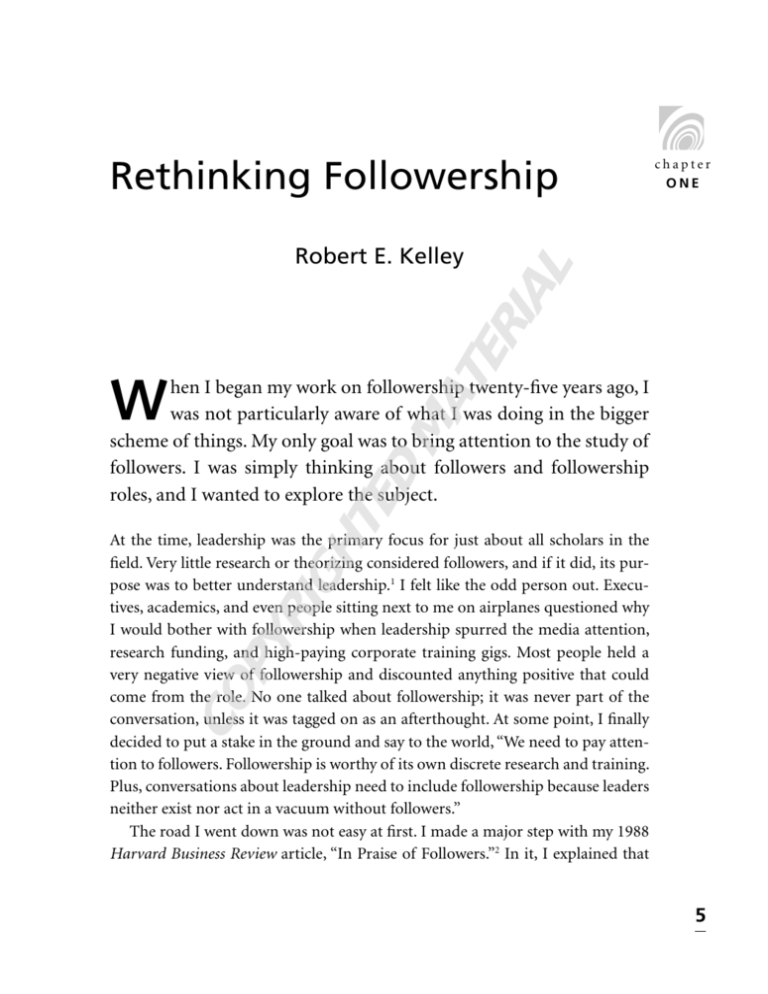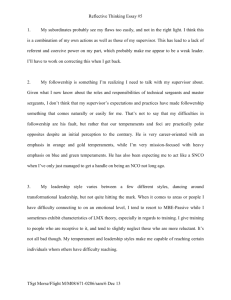copyrighted material
advertisement

Rethinking Followership TE RI AL Robert E. Kelley 0 chapter ONE W TE D MA hen I began my work on followership twenty-five years ago, I was not particularly aware of what I was doing in the bigger scheme of things. My only goal was to bring attention to the study of followers. I was simply thinking about followers and followership roles, and I wanted to explore the subject. CO PY RI GH At the time, leadership was the primary focus for just about all scholars in the field. Very little research or theorizing considered followers, and if it did, its purpose was to better understand leadership.1 I felt like the odd person out. Executives, academics, and even people sitting next to me on airplanes questioned why I would bother with followership when leadership spurred the media attention, research funding, and high-paying corporate training gigs. Most people held a very negative view of followership and discounted anything positive that could come from the role. No one talked about followership; it was never part of the conversation, unless it was tagged on as an afterthought. At some point, I finally decided to put a stake in the ground and say to the world, “We need to pay attention to followers. Followership is worthy of its own discrete research and training. Plus, conversations about leadership need to include followership because leaders neither exist nor act in a vacuum without followers.” The road I went down was not easy at first. I made a major step with my 1988 Harvard Business Review article, “In Praise of Followers.”2 In it, I explained that 5 we view the world as a map with leadership in the center and everything else on the periphery. I remember a perspective-altering trip to Japan, where I was shown a world map with Japan in the center and the United States tucked over in the corner. This is what I wanted to do for followership: to put it in the middle of the map and to let everything else be on the periphery. “In Praise of Followers” turned out to be fairly controversial. Some people just flat out didn’t like it, comparing followers to sled dogs whose destiny is always to look at the rear end of the dog in front of them, but never to see the wider horizon or make the decisions of the lead dog. Other readers could not thank me enough for articulating what they secretly held in their heart. These folks believed that being a strong #2 often allowed for greater contributions than being in the #1 spot and that making the assist was just as important as making the score. Many had no desire to be leaders. Controversy, I learned, can be good for spreading the word. So many people read, discussed, argued, and tried to apply the ideas in the article that it became one of HBR’s best-selling reprints and earned the article the “HBR Classic” designation. My 1992 book, The Power of Followership, and Ira Chaleff’s 1995 book, The Courageous Follower, propelled the concept even further.3 In the years since then, followership has made increasing headway into the mainstream, and the amount of interest in the topic seems to be escalating. For example, the word itself is now part of the organizational vocabulary. It is rare for someone to talk about leadership without also discussing the corresponding role of followership. Most leadership courses now have a section devoted to followership, and followership is increasingly taught as a stand-alone course in universities and corporations, such as Barbara Kellerman’s followership course at Harvard’s Kennedy School. Several master’s theses and doctoral dissertations have studied followership in nursing, education, business, and sports. A 2007 Google search turned up over 187,000 hits for the term follower and over 92,000 hits for followership research. Ron Riggio, Jean Lipman-Blumen, and Ira Chaleff organized at Claremont McKenna College in 2006 the first national followership conference. On a personal level, more and more people contact me now wanting to know about followership. Most important, more people admit to me that they not only play the followership role but also prefer it. The landscape for followership has changed considerably in the last twenty-five years. 6 The Art of Followership FOLLOWERSHIP STYLES My previous work, which served as a launching point for the field, involved basic preliminary research on the styles of followership. Two dimensions seemed to define the way that people follow: 1. Do they think for themselves? Are they independent critical thinkers? Or do they look to the leader to do the thinking for them? 2. Are they actively engaged in creating positive energy for the organization? Or is there negative energy or passive involvement? Based on these two dimensions, there are five basic styles of followership: The sheep. Sheep are passive and look to the leader to do the thinking for them and to motivate them. If you are the boss and in your car on the way to work, and you’re thinking about what you’re going to get your workers to do and how you’re going to do that, then you’re dealing with sheep. The yes-people. Yes-people are positive, always on the leader’s side, but still looking to the leader for the thinking, the direction, the vision. If the leader asks them to do something, they’ve got the energy, and they’ll go forward with it. When they finish that task, they’ll come back to the leader, asking, “What do you want me to do next?” However, yes-people don’t see themselves this way. One of the things I’ve learned is that the different styles of followers will almost always put a positive spin on their style. Yes-people will say, “I’m a doer; that’s my job. The boss gets paid to think, and I’m the one who does the work.” But the rest of us would say there’s more to being a good follower than simply doing. The alienated. Alienated followers think for themselves, but have a lot of negative energy. Every time the leader or organization tries to move forward, these are the ones who have ten reasons why the leader or organization shouldn’t. They are not coming up with the next solution, but are skeptical, cynical about the current plan of action. They have energy, they can think for themselves, they can be smart. But they are not moving in a positive direction. However, they see themselves as the mavericks, the only people in the organization who have the guts to stand up to the boss. The pragmatics. Pragmatics sit on the fence and see which way the wind blows. Once they see where things are headed, they’ll get on board. They’ll never be the first on board, but they will never let the leader or organization leave Rethinking Followership 7 without them. They see themselves as preservers of the status quo. Their internal dialogue goes something like this: “If I got all excited every time there was a new leader or a change of direction, my wheels would be spinning constantly. Leaders come and go. New visions come and go. If I just sit here and wait it out, I won’t have to do all that work.” So they do what they must to survive, but wait it out until the storms of change blow over. The star followers. Star followers think for themselves, are very active, and have very positive energy. They do not accept the leader’s decision without their own independent evaluation of its soundness. If they agree with the leader, they give full support. If they disagree, they challenge the leader, offering constructive alternatives that will help the leader and organization get where they want to go. Some people view these people as really “leaders in disguise,” but this is basically because those people have a hard time accepting that followers can display such independence and positive behavior. Star followers are often referred to as “my right-hand person” or my “go-to person.” 0 So this was the basic model I used to understand followership styles. It offered me and a number of organizations a way to think about the type of behavior that led to all the negative stereotypes, as well as to conceive of the positive followership that rarely got mentioned. In my work, I try not to ignore reality or feedback. Rather than pretend that the negative stereotypes did not exist and come up with some idealized follower that the world should embrace, I wanted to explore the full reality of how people follow. Are people stuck in followership styles? Is a person’s style static or dynamic? Once you are a pragmatic, are you always a pragmatic? Or do people’s styles change depending on the leader they have or the job they find themselves in? Can a person be a star follower in one situation and an alienated follower in another situation? Why do people adopt a particular style? Why would someone end up as a pragmatic follower? What conditions might lead to that? Are there ways to help people move toward a chosen style? This model, in my experience, tends to be very powerful for people, having a lot of face validity as well as some statistical validity. For example, when my colleagues and I teach a weeklong leadership program at Carnegie Mellon University, 8 The Art of Followership I am no longer surprised that the overwhelming response from the participants about what opened their eyes the most, the thing that got them the most excited, is the followership model. So I continue to use it. RETHINKING FOLLOWERSHIP As I look forward for the field of followership, my thoughts swirl around the following seven topics: 1. World events 2. Culture 3. Leader(ship) 4. Follower qualities 5. Role of the follower 6. Language of followership 7. Courageous conscience In some of these areas, I think followership should be playing a more important role than it is. In other areas, I see research opportunities for all the scholars involved in the field. World Events One of the things I’m concerned about is that we scholars have gotten too “micro” and too “parochial” when discussing followership. We overly examine the followerleader interaction on the small stage of college student life or coach-player dramas. Can followership help us unravel the big issues happening in the world, issues that affect many people’s lives—suicide bombers; the rise of religious fundamentalism and its corresponding lack of tolerance; democratically elected dictators and corrupt government officials of any kind who harm their followers and the larger society; or corporate abuses of power that cheat employees, customers, suppliers, investors, and in some cases the larger society?4 For example, the increase in suicide bombings and in the types of suicide bombers (for example, more women, more middle-class people, more professionals) has much of society searching for an explanation. If we take a psychological approach, we might look for answers in the bombers’ needs for power, revenge, Rethinking Followership 9 or the promise of heaven. We might also see it from an economic vantage point in that the bombers are guaranteed the economic well-being of their families in return for their acts. Or we could search for sociological root causes, such as poverty, unemployment, or societal disenfranchisement. Each of these inquiries might yield some valuable insights. My question is, Why are we not making a followership inquiry into the issue of suicide bombers? Surely followership plays a role and might offer more powerful insights into the phenomenon. What kind of followers are suicide bombers? Are they sheep, pragmatics, or star followers? What motivates their followership? Are they disciples, dreamers, or something else? What human needs are at work? Can the world “afford” this type of followership? Would more “enlightened” followership reduce the occurrence of and damage done by this behavior (or any of the others that I mentioned earlier)? How can any of the scholarly work on followership help us answer these questions? How do we unlock the practical applications of our knowledge about followership? It seems to me that followership could help us address these world events equally as well as leadership can. Culture Culture affects people’s belief systems and behaviors. So do we need to consider the cultural aspects of followership? If you were raised in Japan, are you going to think about followership and carry out the role differently than if you were raised in the United States or Kenya? In terms of religion, if you were brought up in the Judaic tradition, you arrive at truth by questioning. That is a very different approach than that of evangelical fundamentalists, who are supposed to accept on faith. These perspectives will likely produce different approaches to followership, and it would help if we understood these differences. In our suicide bomber example, how does culture affect followership? Which factors (for example, country of origin, ethnic identity, or religious background) affect culture the most, and how do these factors play a role in a suicide bomber’s followership behavior? Followership is also influenced at the subcultural level. Consider how followership varies between civilian employees versus those in the military, members of tribes versus urban residents, or prison inmates versus members of middle-class society. This is just a starter list that can energize our inquiries. Do some cultures produce more yes-people or star followers? If so, then why? Do cultures characterize followership differently, thus producing different 10 The Art of Followership followership styles and behaviors that are not generalizable across cultures? Or are there universal followership styles, motivations, and role performance? We can take this a step further and look at followership during cultural clashes. When a culture that advocates free speech and a free press produces a political cartoon that is viewed as insulting by another culture, how does followership play out? What drives followers in the offended group to start rioting and harming members of the free speech culture? What makes the followers in the free speech culture surprised by this retaliation, but not retaliate in return? Leader(ship) Traditionally, we have viewed the world from a leadership-centric vantage point. We have assumed that all other factors, including followership, are secondary to leadership. When followers have been surveyed, it was to determine their views of the leaders. But what if we turned all this around? What if we put followership center stage and asked all the same questions, but only in reference to the followers instead of leaders? For example, when we talk about leader-follower distance, we always talk about the follower’s distance from the leader, but we should also talk about the leader’s distance from the follower. Likewise, what are the interactions between leaders and followers from the follower’s point of view? We tend to think of leaders as the proactive “cause” and followership as the reactive “effect.” But what if the opposite were true? Are leadership attitudes, behavior, and performance more a result of followership than the other way around? For example, do sheep produce a particular style of leadership, regardless of the leader’s personality or predisposition? Is it this turn of events that leads to a particular outcome? I’m reminded of the psychology cartoon depicting two dogs in a park talking to each other. One says to the other, “Humans are hard to train, but once you break them in, they are pretty predictable. I’ve finally taught mine so that when I bark, he drops whatever he’s doing and prepares my meal. When I feel like getting some exercise, I scratch the floor to signal him to get on his jacket and to walk alongside of me to keep me company. And when I need a massage, I just sit down next to him and he starts rubbing me. He’s learned these things so well that I don’t even have to say anything anymore.” We tend to believe that the leaders are in charge, directing and shaping followership behavior. Yet maybe leaders are malleable products of cumulative followership actions. Rethinking Followership 11 We might also reframe the interaction effects between followers and leaders. For example, when we talk about charismatic leadership, we can ask, What style of follower would a charismatic leader attract? However, we should also ask, What style of leader would a yes-person attract? What is the psychological and emotional dynamic between them? These possible interactions between different followership and leadership styles, and the complexity therein, would be fertile areas for research, complementing Kellerman’s and Lipman-Blumen’s work on bad leaders.5 This topic also ties in to the aforementioned world events and culture areas. Follower Qualities The question that still sticks in my head after twenty-plus years is, In our society, why does anyone want to be a follower, when all the perks and all the attention go to leaders? Although I identified seven paths to followership in my book The Power of Followership, we still have a long way to go to understand it more fully. For example, college applications ask for examples of leadership, but not of followership. It would be an unusual kid who would take the risk to extol followership qualities and the even more unusual admissions officer who would reward it. So from where do followership attitudes, styles, and aspirations come? What’s the role of parenting, early childhood experience, school, religion, sports participation, the media, or important role models on followership development? Consider peer pressure in middle school, for example. Most of the serious social issues students may face—alcohol and drug experimentation, gangs, sex, fear of social ostracism—are peer-pressure driven. Schools treat peer pressure as a leadership issue when actually it’s a followership issue. They believe that if they teach leadership skills, they will alleviate the negative effects of peer pressure. A better approach may be to teach better followership skills. Kids need to learn how to protect themselves from leaders who encourage them to engage in either selfdestructive or socially destructive behavior, as well as learn how to support positive leaders. But peer pressure and toxic leaders are not just a middle school problem. Many of the world events mentioned earlier involve peer pressure and toxic leaders. We need to learn what life events produce followers who can think for themselves; exercise their own independent, critical judgment; and act in the best interests 12 The Art of Followership of the organization or the society, even if doing so means going against the leader or the group. Role of the Follower One of the questions that I ask executives is, “If you could have an ideal mix of the five followership styles in your organization, what percentage of each style would you prefer?” I’m surprised at how many say they would like all yes-people. Their reasons are that (1) yes-people are “doers” who are willing to do the grunt work and who get the job done with little fuss; (2) yes-people have limited aspirations and will neither pressure the leader for promotions nor quit for better jobs elsewhere; and (3) yes-people are loyal and dependable. Other executives say they would prefer the following mix. Start with a sprinkling of alienated because they keep the leader honest. Add a small group of star followers who would lead the charge, but avoid adding too many because they can get demanding, and they think for themselves too much. Then split the remaining majority among pragmatics who serve as an institutionalized, status quo base and yes-people who will get the job done. It is the rare executive who wants all star followers. Most executives fear that they can neither keep star followers challenged by the job nor satisfied with their role in the organization. They believe that star followers will grow bored and disillusioned, seeking greener pastures and leading to high turnover. My own experience is that organizations with more star followers perform better because the star followers need not depend on the leader for direction or motivation. This reduces the transaction costs that hinder organizational success. Pondering the roles of followers results in intriguing research questions. What assumptions do leaders make about the various followership styles? Are those assumptions accurate, or are they dysfunctional stereotypes? Is the common leader preference for loyal doers justified or problematic? Is there an ideal mix of followership styles, or is the search for such a mix a quixotic quest? Is the ideal mix dependent on the context or situation? Do certain mixes attract certain types of leaders? Do certain leaders reshape the mix to suit their own preference? If we prefer a certain mix, say all star followers, can people move from one followership style to another, such as from yes-person to star follower? If so, how does that happen? Rethinking the role of followers can help the field move forward. Rethinking Followership 13 Language of Followership If I had a dollar for every time someone said to me, “You need to come up with a word other than ‘follower’ because it’s socially unacceptable,” I would be much wealthier today. “If you had a sexier, easier term,” they say, “then you’d be able to sell this concept much more easily.” My response is always “I would be glad to do that as soon as we get rid of the word ‘leader.’ Once you’re ready to do that, then we can talk.” My rigid stance actually stems from the point that these people are making— that language does make a difference. Language has an effect. If we stop using “follower” (as some businesses, such as Wal-Mart, have done, using words like “associate” in its place), can we really continue to use the word “leader”? Does “leader-associate” have the same dialectical relationship as “leader-follower”? I think not. Instead, it masks the underlying beliefs that the leaders have about their “associates” with a more democratic sheen. Language is important not only in terms of the words we use but also in terms of the script that they suggest. The words “leader” and “follower” bring to mind a common script in which the leader is in charge, saying, “You do this, and you do that.” Meanwhile, followers are imagined as inferior beings in need of the leader’s direction, motivation, and protection. We need to rethink this outdated script. What societal purpose does it serve? Is it still functional in today’s world? What personal purpose does it serve for the people who promulgate it or for the people who actually follow it? We need to ask ourselves whether we need a new script. Can we start to reframe the entire conversation in a new way? If so, what does the new script sound like? What words and imagery do we use to suggest either a more accurate or a more desirable relationship between followers and leaders? Courageous Conscience Related to the issue of peer pressure discussed earlier is the responsibility that followers have to keep leaders and peers ethically and legally in check. Instead of viewing followers as the “good soldiers” who carry out commands dutifully, we need to view followers as the primary defenders against toxic leaders or dysfunctional organizations. The buck stops more with followers than leaders. In fact, they are often in a better position to see the day-to-day events or leader decisions that lead to disastrous consequences. However, our current script of followership does not include this responsibility in the role description. For the most part, society 14 The Art of Followership neither prepares nor expects followers to exercise what I label as the “courageous conscience.” The ability to make ethical and legal judgments, to take proactive steps to promote ethical and legal activities, and then to stand up against unethical and illegal decisions and actions, is a crucial aspect of followership. Followers cannot abdicate their courageous conscience by outsourcing it to the leader. Rather, followers need to learn how to blow the whistle effectively, how to combat groupthink, how to avoid the dispersion of responsibility so often found in groups, and how to advance institutional integrity. How do we make this happen? How do we help people be successful when they have to stand up? The answer has at least three parts: (1) teaching people that the followership role includes the courageous conscience, thus not only legitimating this responsibility but also mandating it; (2) helping followers find the personal courage to stand up, and providing the societal supports that encourage people to exercise their courageous conscience; and (3) preparing followers so that when they do stand up, they are successful. If all followers actively used their courageous conscience, we would likely have fewer toxic leaders who steer the organization down the path of organizational corruption or societal damage. This could go a long way in limiting the fallout of the world events I discussed earlier. To this end, I would like someone to develop an entire curriculum that brings the ethical, legal, and social science tools together to equip every person with a strong, active courageous conscience. CONCLUSION The field of followership is still in its infancy. It is rare that people get a chance to build and shape a new area of inquiry. This twenty-five-year journey has been a wonderful experience for me: when I started, I only wanted to put my stake in the ground, and now many people have joined the journey, taking it in new directions. I am confident that fellow travelers will generate their own ways to rethink the followership field and create novel research agendas. Collectively, we can grow the followership field so that it makes powerful contributions to society and to the individuals who make up society. Rethinking Followership 15









